Risk Management Plan: Analysis of the Fukushima Plant Incident
VerifiedAdded on 2020/03/04
|23
|5615
|184
Report
AI Summary
This report presents a risk management plan focusing on the Fukushima nuclear plant incident, utilizing the AS/NZS ISO 31000:2009 standards as a framework. It analyzes the incident, highlighting the overlooked risks associated with the tsunami and its impact on the plant's safety. The report includes a literature review of risk assessment principles, applicable theories, and methodologies like FMEA (Failure Mode and Effects Analysis), as well as a discussion on risk tolerability criteria. The study emphasizes the significance of the Fukushima incident in evaluating the reliability of risk assessments in the nuclear power industry globally. The report concludes with a discussion and analysis of the incident, referencing relevant studies and including figures such as fault trees and RBDs (Reliability Block Diagrams). The plan aims to improve safety levels and address public perceptions regarding nuclear energy through a comprehensive risk management approach.
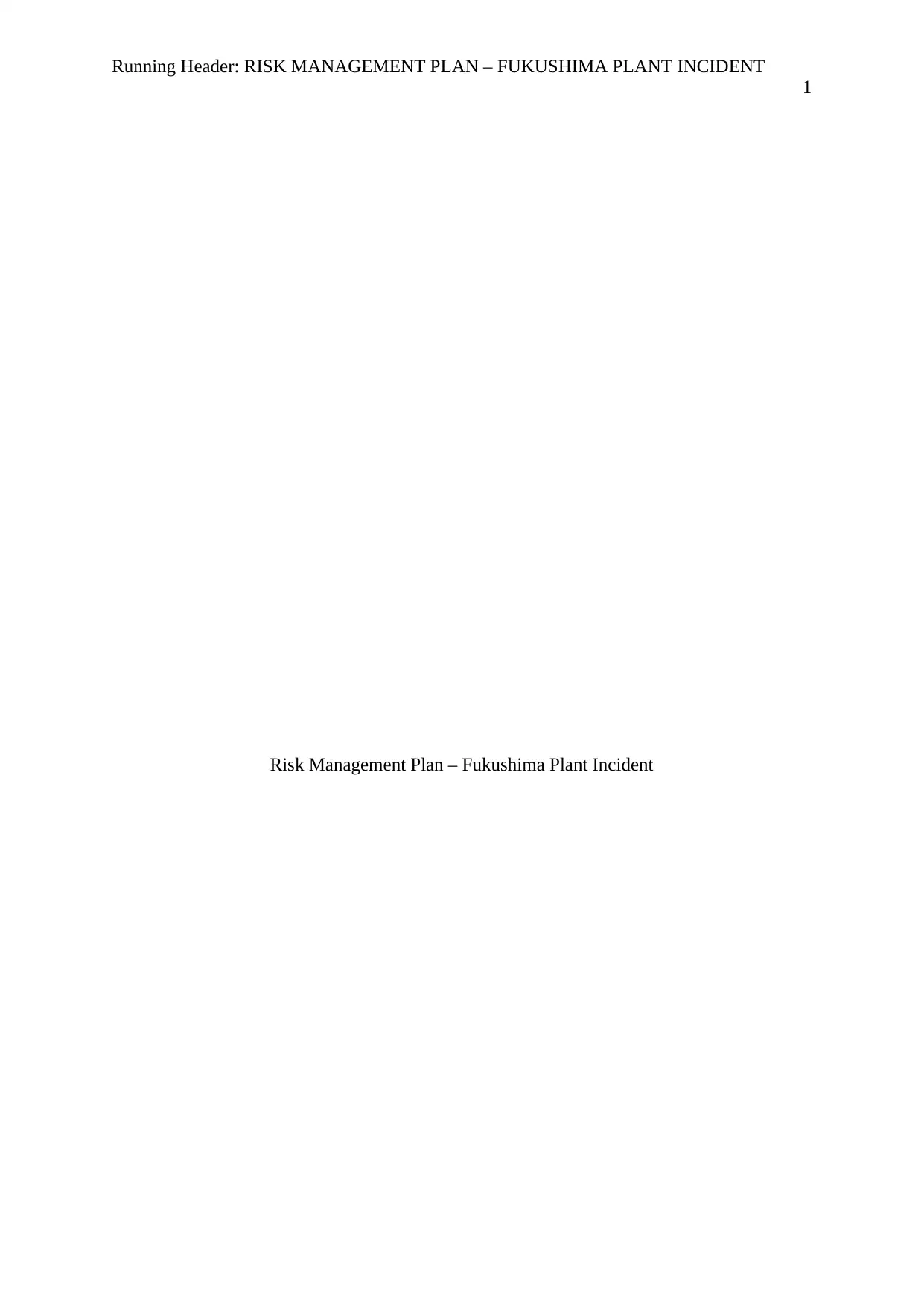
Running Header: RISK MANAGEMENT PLAN – FUKUSHIMA PLANT INCIDENT
1
Risk Management Plan – Fukushima Plant Incident
1
Risk Management Plan – Fukushima Plant Incident
Paraphrase This Document
Need a fresh take? Get an instant paraphrase of this document with our AI Paraphraser
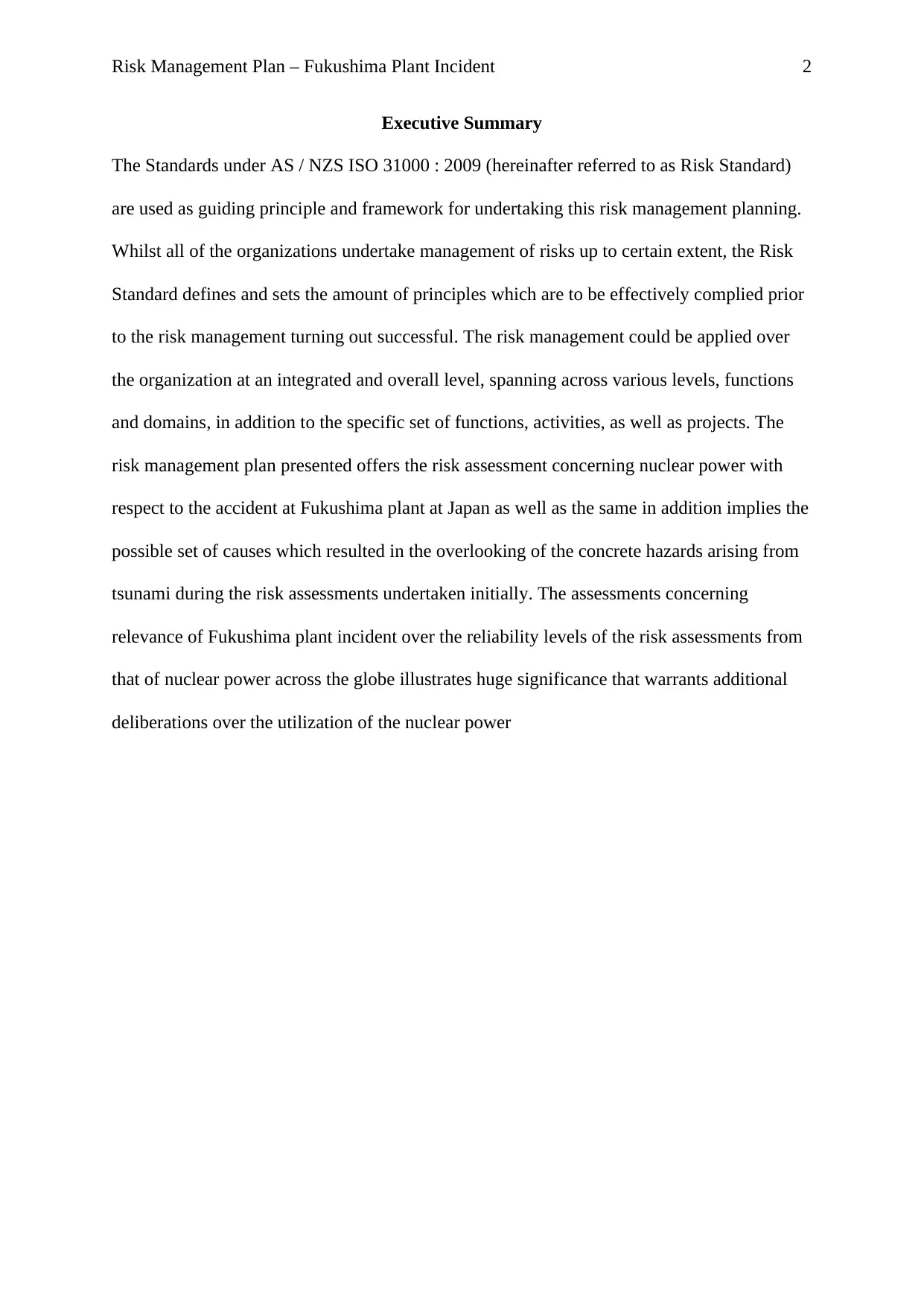
Risk Management Plan – Fukushima Plant Incident 2
Executive Summary
The Standards under AS / NZS ISO 31000 : 2009 (hereinafter referred to as Risk Standard)
are used as guiding principle and framework for undertaking this risk management planning.
Whilst all of the organizations undertake management of risks up to certain extent, the Risk
Standard defines and sets the amount of principles which are to be effectively complied prior
to the risk management turning out successful. The risk management could be applied over
the organization at an integrated and overall level, spanning across various levels, functions
and domains, in addition to the specific set of functions, activities, as well as projects. The
risk management plan presented offers the risk assessment concerning nuclear power with
respect to the accident at Fukushima plant at Japan as well as the same in addition implies the
possible set of causes which resulted in the overlooking of the concrete hazards arising from
tsunami during the risk assessments undertaken initially. The assessments concerning
relevance of Fukushima plant incident over the reliability levels of the risk assessments from
that of nuclear power across the globe illustrates huge significance that warrants additional
deliberations over the utilization of the nuclear power
Executive Summary
The Standards under AS / NZS ISO 31000 : 2009 (hereinafter referred to as Risk Standard)
are used as guiding principle and framework for undertaking this risk management planning.
Whilst all of the organizations undertake management of risks up to certain extent, the Risk
Standard defines and sets the amount of principles which are to be effectively complied prior
to the risk management turning out successful. The risk management could be applied over
the organization at an integrated and overall level, spanning across various levels, functions
and domains, in addition to the specific set of functions, activities, as well as projects. The
risk management plan presented offers the risk assessment concerning nuclear power with
respect to the accident at Fukushima plant at Japan as well as the same in addition implies the
possible set of causes which resulted in the overlooking of the concrete hazards arising from
tsunami during the risk assessments undertaken initially. The assessments concerning
relevance of Fukushima plant incident over the reliability levels of the risk assessments from
that of nuclear power across the globe illustrates huge significance that warrants additional
deliberations over the utilization of the nuclear power
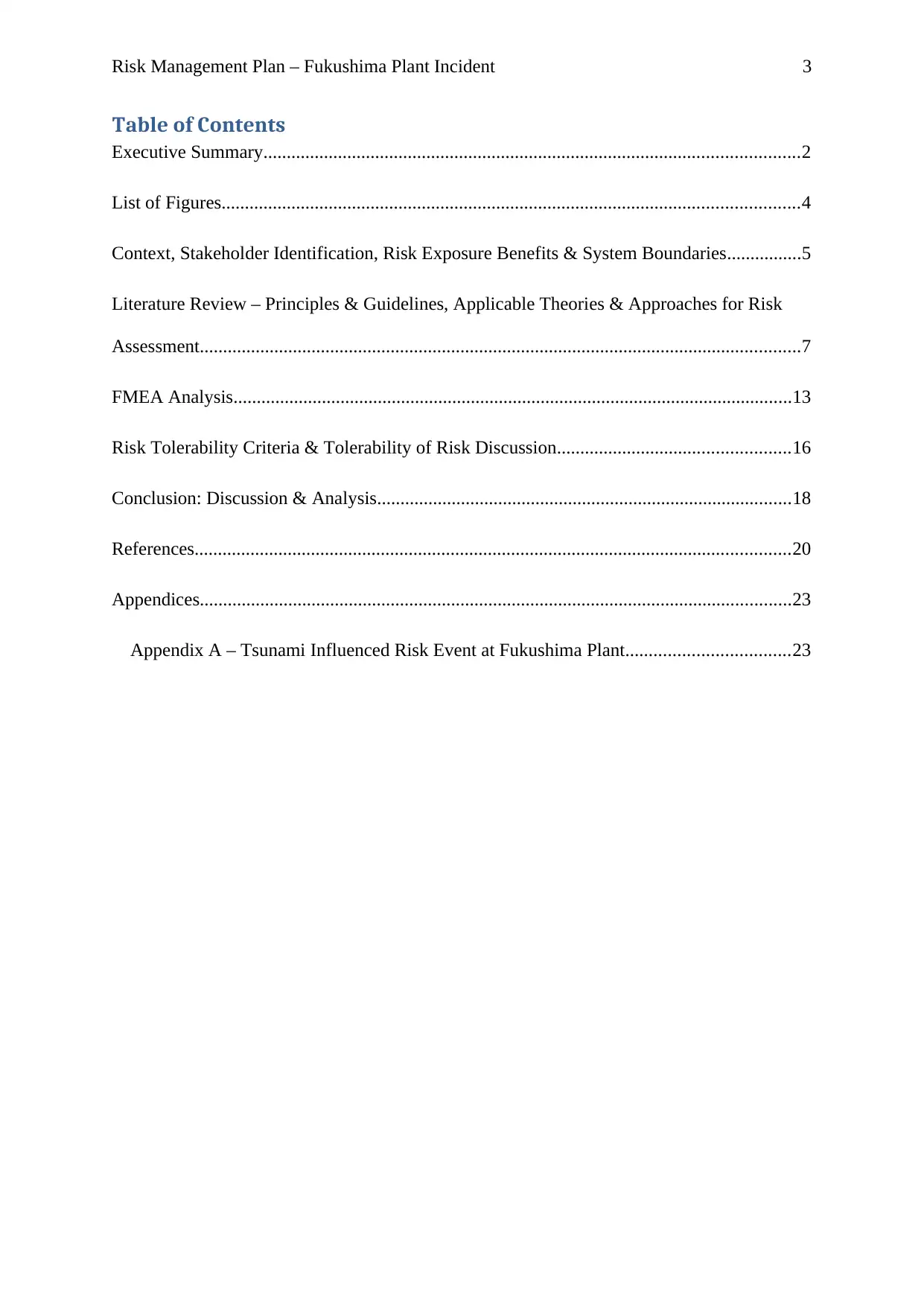
Risk Management Plan – Fukushima Plant Incident 3
Table of Contents
Executive Summary...................................................................................................................2
List of Figures............................................................................................................................4
Context, Stakeholder Identification, Risk Exposure Benefits & System Boundaries................5
Literature Review – Principles & Guidelines, Applicable Theories & Approaches for Risk
Assessment.................................................................................................................................7
FMEA Analysis........................................................................................................................13
Risk Tolerability Criteria & Tolerability of Risk Discussion..................................................16
Conclusion: Discussion & Analysis.........................................................................................18
References................................................................................................................................20
Appendices...............................................................................................................................23
Appendix A – Tsunami Influenced Risk Event at Fukushima Plant...................................23
Table of Contents
Executive Summary...................................................................................................................2
List of Figures............................................................................................................................4
Context, Stakeholder Identification, Risk Exposure Benefits & System Boundaries................5
Literature Review – Principles & Guidelines, Applicable Theories & Approaches for Risk
Assessment.................................................................................................................................7
FMEA Analysis........................................................................................................................13
Risk Tolerability Criteria & Tolerability of Risk Discussion..................................................16
Conclusion: Discussion & Analysis.........................................................................................18
References................................................................................................................................20
Appendices...............................................................................................................................23
Appendix A – Tsunami Influenced Risk Event at Fukushima Plant...................................23
⊘ This is a preview!⊘
Do you want full access?
Subscribe today to unlock all pages.

Trusted by 1+ million students worldwide
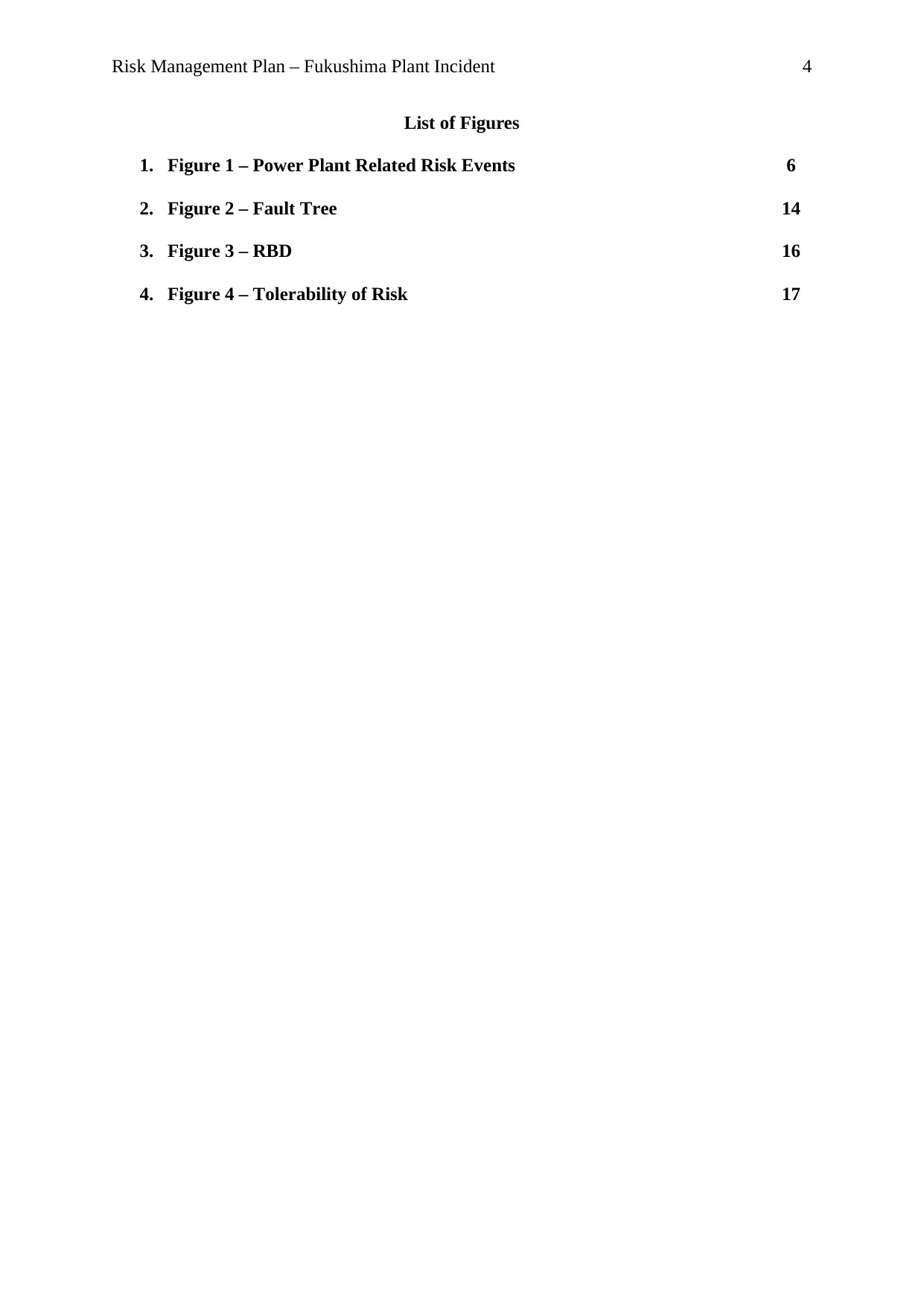
Risk Management Plan – Fukushima Plant Incident 4
List of Figures
1. Figure 1 – Power Plant Related Risk Events 6
2. Figure 2 – Fault Tree 14
3. Figure 3 – RBD 16
4. Figure 4 – Tolerability of Risk 17
List of Figures
1. Figure 1 – Power Plant Related Risk Events 6
2. Figure 2 – Fault Tree 14
3. Figure 3 – RBD 16
4. Figure 4 – Tolerability of Risk 17
Paraphrase This Document
Need a fresh take? Get an instant paraphrase of this document with our AI Paraphraser
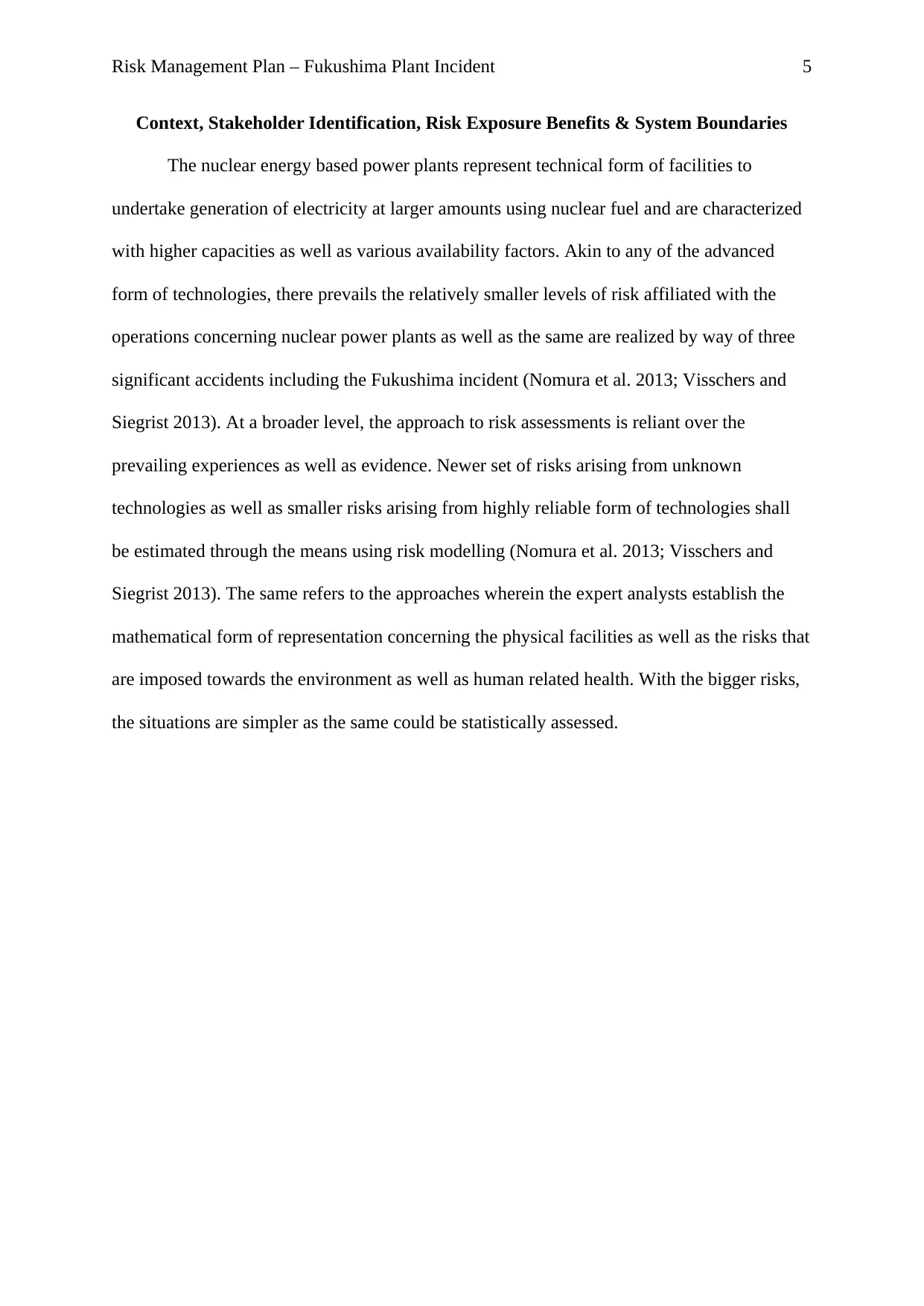
Risk Management Plan – Fukushima Plant Incident 5
Context, Stakeholder Identification, Risk Exposure Benefits & System Boundaries
The nuclear energy based power plants represent technical form of facilities to
undertake generation of electricity at larger amounts using nuclear fuel and are characterized
with higher capacities as well as various availability factors. Akin to any of the advanced
form of technologies, there prevails the relatively smaller levels of risk affiliated with the
operations concerning nuclear power plants as well as the same are realized by way of three
significant accidents including the Fukushima incident (Nomura et al. 2013; Visschers and
Siegrist 2013). At a broader level, the approach to risk assessments is reliant over the
prevailing experiences as well as evidence. Newer set of risks arising from unknown
technologies as well as smaller risks arising from highly reliable form of technologies shall
be estimated through the means using risk modelling (Nomura et al. 2013; Visschers and
Siegrist 2013). The same refers to the approaches wherein the expert analysts establish the
mathematical form of representation concerning the physical facilities as well as the risks that
are imposed towards the environment as well as human related health. With the bigger risks,
the situations are simpler as the same could be statistically assessed.
Context, Stakeholder Identification, Risk Exposure Benefits & System Boundaries
The nuclear energy based power plants represent technical form of facilities to
undertake generation of electricity at larger amounts using nuclear fuel and are characterized
with higher capacities as well as various availability factors. Akin to any of the advanced
form of technologies, there prevails the relatively smaller levels of risk affiliated with the
operations concerning nuclear power plants as well as the same are realized by way of three
significant accidents including the Fukushima incident (Nomura et al. 2013; Visschers and
Siegrist 2013). At a broader level, the approach to risk assessments is reliant over the
prevailing experiences as well as evidence. Newer set of risks arising from unknown
technologies as well as smaller risks arising from highly reliable form of technologies shall
be estimated through the means using risk modelling (Nomura et al. 2013; Visschers and
Siegrist 2013). The same refers to the approaches wherein the expert analysts establish the
mathematical form of representation concerning the physical facilities as well as the risks that
are imposed towards the environment as well as human related health. With the bigger risks,
the situations are simpler as the same could be statistically assessed.
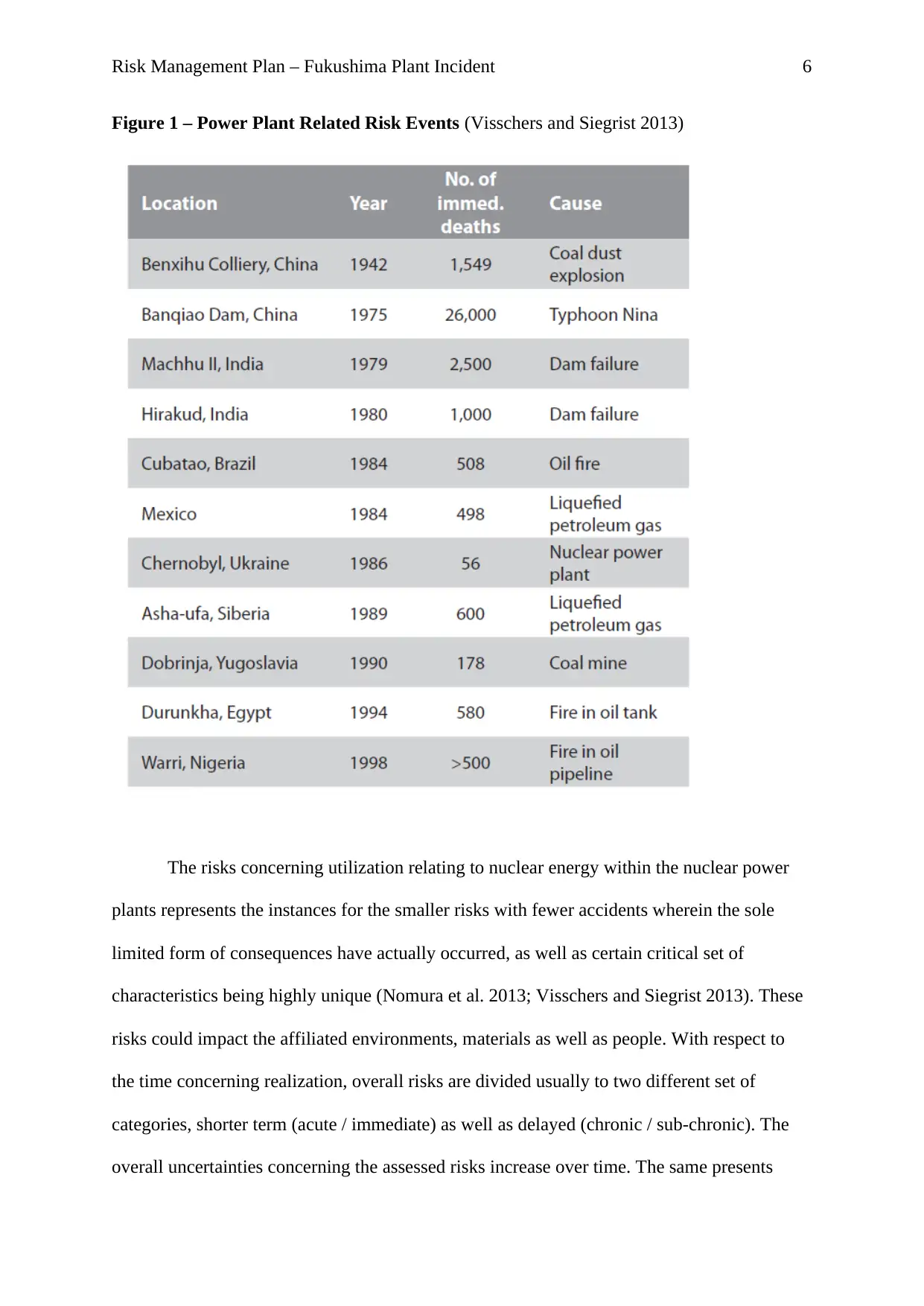
Risk Management Plan – Fukushima Plant Incident 6
Figure 1 – Power Plant Related Risk Events (Visschers and Siegrist 2013)
The risks concerning utilization relating to nuclear energy within the nuclear power
plants represents the instances for the smaller risks with fewer accidents wherein the sole
limited form of consequences have actually occurred, as well as certain critical set of
characteristics being highly unique (Nomura et al. 2013; Visschers and Siegrist 2013). These
risks could impact the affiliated environments, materials as well as people. With respect to
the time concerning realization, overall risks are divided usually to two different set of
categories, shorter term (acute / immediate) as well as delayed (chronic / sub-chronic). The
overall uncertainties concerning the assessed risks increase over time. The same presents
Figure 1 – Power Plant Related Risk Events (Visschers and Siegrist 2013)
The risks concerning utilization relating to nuclear energy within the nuclear power
plants represents the instances for the smaller risks with fewer accidents wherein the sole
limited form of consequences have actually occurred, as well as certain critical set of
characteristics being highly unique (Nomura et al. 2013; Visschers and Siegrist 2013). These
risks could impact the affiliated environments, materials as well as people. With respect to
the time concerning realization, overall risks are divided usually to two different set of
categories, shorter term (acute / immediate) as well as delayed (chronic / sub-chronic). The
overall uncertainties concerning the assessed risks increase over time. The same presents
⊘ This is a preview!⊘
Do you want full access?
Subscribe today to unlock all pages.

Trusted by 1+ million students worldwide
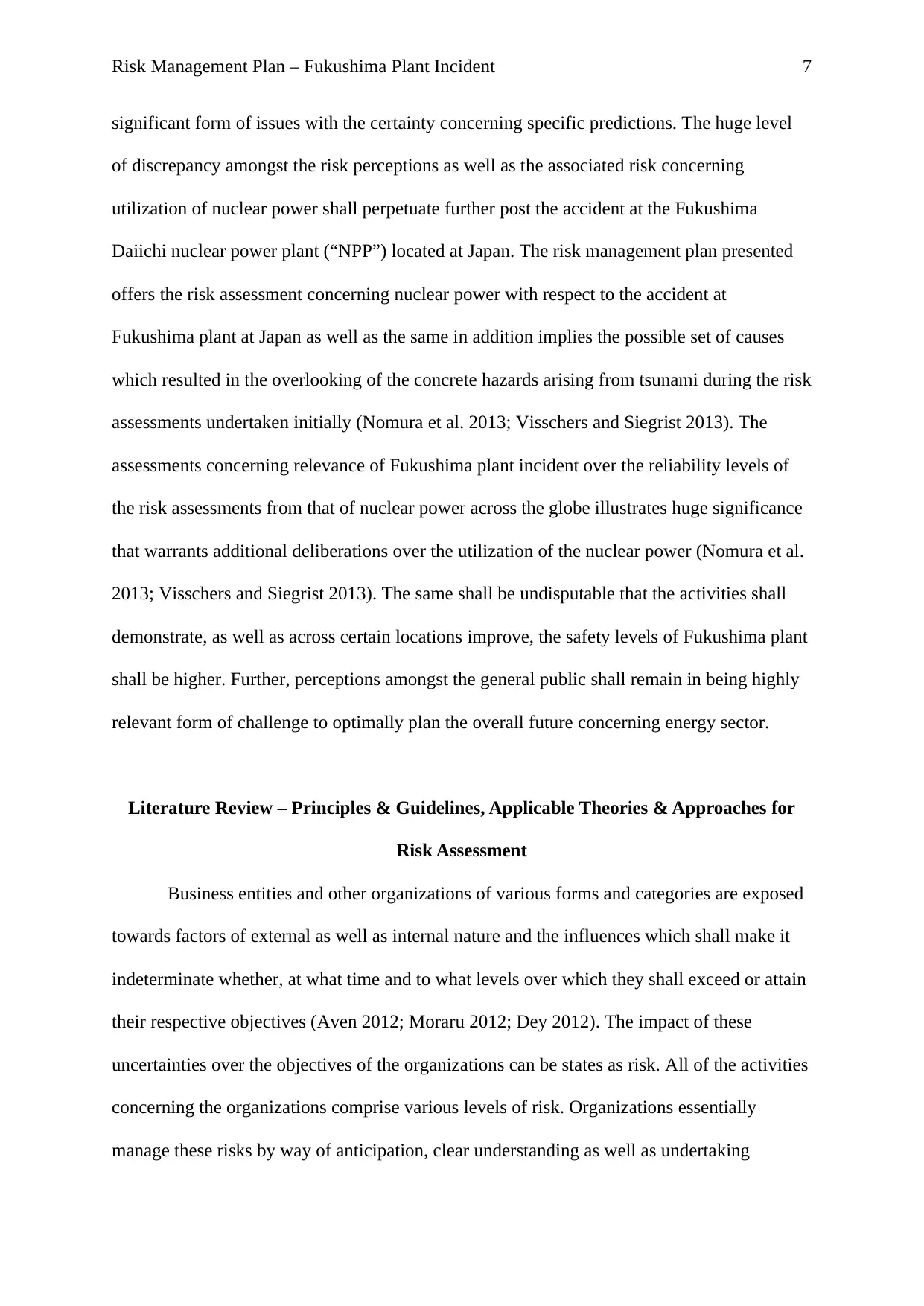
Risk Management Plan – Fukushima Plant Incident 7
significant form of issues with the certainty concerning specific predictions. The huge level
of discrepancy amongst the risk perceptions as well as the associated risk concerning
utilization of nuclear power shall perpetuate further post the accident at the Fukushima
Daiichi nuclear power plant (“NPP”) located at Japan. The risk management plan presented
offers the risk assessment concerning nuclear power with respect to the accident at
Fukushima plant at Japan as well as the same in addition implies the possible set of causes
which resulted in the overlooking of the concrete hazards arising from tsunami during the risk
assessments undertaken initially (Nomura et al. 2013; Visschers and Siegrist 2013). The
assessments concerning relevance of Fukushima plant incident over the reliability levels of
the risk assessments from that of nuclear power across the globe illustrates huge significance
that warrants additional deliberations over the utilization of the nuclear power (Nomura et al.
2013; Visschers and Siegrist 2013). The same shall be undisputable that the activities shall
demonstrate, as well as across certain locations improve, the safety levels of Fukushima plant
shall be higher. Further, perceptions amongst the general public shall remain in being highly
relevant form of challenge to optimally plan the overall future concerning energy sector.
Literature Review – Principles & Guidelines, Applicable Theories & Approaches for
Risk Assessment
Business entities and other organizations of various forms and categories are exposed
towards factors of external as well as internal nature and the influences which shall make it
indeterminate whether, at what time and to what levels over which they shall exceed or attain
their respective objectives (Aven 2012; Moraru 2012; Dey 2012). The impact of these
uncertainties over the objectives of the organizations can be states as risk. All of the activities
concerning the organizations comprise various levels of risk. Organizations essentially
manage these risks by way of anticipation, clear understanding as well as undertaking
significant form of issues with the certainty concerning specific predictions. The huge level
of discrepancy amongst the risk perceptions as well as the associated risk concerning
utilization of nuclear power shall perpetuate further post the accident at the Fukushima
Daiichi nuclear power plant (“NPP”) located at Japan. The risk management plan presented
offers the risk assessment concerning nuclear power with respect to the accident at
Fukushima plant at Japan as well as the same in addition implies the possible set of causes
which resulted in the overlooking of the concrete hazards arising from tsunami during the risk
assessments undertaken initially (Nomura et al. 2013; Visschers and Siegrist 2013). The
assessments concerning relevance of Fukushima plant incident over the reliability levels of
the risk assessments from that of nuclear power across the globe illustrates huge significance
that warrants additional deliberations over the utilization of the nuclear power (Nomura et al.
2013; Visschers and Siegrist 2013). The same shall be undisputable that the activities shall
demonstrate, as well as across certain locations improve, the safety levels of Fukushima plant
shall be higher. Further, perceptions amongst the general public shall remain in being highly
relevant form of challenge to optimally plan the overall future concerning energy sector.
Literature Review – Principles & Guidelines, Applicable Theories & Approaches for
Risk Assessment
Business entities and other organizations of various forms and categories are exposed
towards factors of external as well as internal nature and the influences which shall make it
indeterminate whether, at what time and to what levels over which they shall exceed or attain
their respective objectives (Aven 2012; Moraru 2012; Dey 2012). The impact of these
uncertainties over the objectives of the organizations can be states as risk. All of the activities
concerning the organizations comprise various levels of risk. Organizations essentially
manage these risks by way of anticipation, clear understanding as well as undertaking
Paraphrase This Document
Need a fresh take? Get an instant paraphrase of this document with our AI Paraphraser
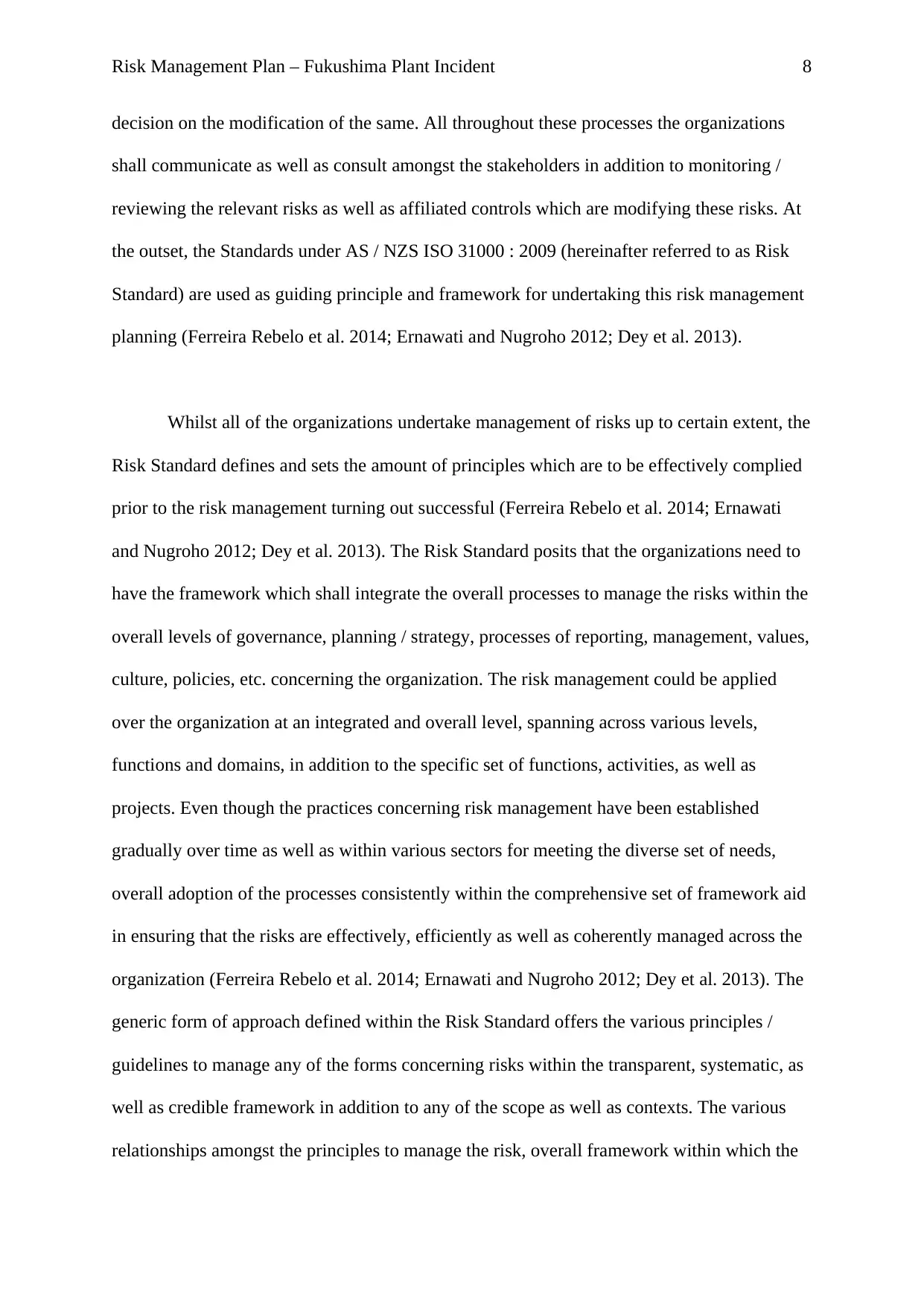
Risk Management Plan – Fukushima Plant Incident 8
decision on the modification of the same. All throughout these processes the organizations
shall communicate as well as consult amongst the stakeholders in addition to monitoring /
reviewing the relevant risks as well as affiliated controls which are modifying these risks. At
the outset, the Standards under AS / NZS ISO 31000 : 2009 (hereinafter referred to as Risk
Standard) are used as guiding principle and framework for undertaking this risk management
planning (Ferreira Rebelo et al. 2014; Ernawati and Nugroho 2012; Dey et al. 2013).
Whilst all of the organizations undertake management of risks up to certain extent, the
Risk Standard defines and sets the amount of principles which are to be effectively complied
prior to the risk management turning out successful (Ferreira Rebelo et al. 2014; Ernawati
and Nugroho 2012; Dey et al. 2013). The Risk Standard posits that the organizations need to
have the framework which shall integrate the overall processes to manage the risks within the
overall levels of governance, planning / strategy, processes of reporting, management, values,
culture, policies, etc. concerning the organization. The risk management could be applied
over the organization at an integrated and overall level, spanning across various levels,
functions and domains, in addition to the specific set of functions, activities, as well as
projects. Even though the practices concerning risk management have been established
gradually over time as well as within various sectors for meeting the diverse set of needs,
overall adoption of the processes consistently within the comprehensive set of framework aid
in ensuring that the risks are effectively, efficiently as well as coherently managed across the
organization (Ferreira Rebelo et al. 2014; Ernawati and Nugroho 2012; Dey et al. 2013). The
generic form of approach defined within the Risk Standard offers the various principles /
guidelines to manage any of the forms concerning risks within the transparent, systematic, as
well as credible framework in addition to any of the scope as well as contexts. The various
relationships amongst the principles to manage the risk, overall framework within which the
decision on the modification of the same. All throughout these processes the organizations
shall communicate as well as consult amongst the stakeholders in addition to monitoring /
reviewing the relevant risks as well as affiliated controls which are modifying these risks. At
the outset, the Standards under AS / NZS ISO 31000 : 2009 (hereinafter referred to as Risk
Standard) are used as guiding principle and framework for undertaking this risk management
planning (Ferreira Rebelo et al. 2014; Ernawati and Nugroho 2012; Dey et al. 2013).
Whilst all of the organizations undertake management of risks up to certain extent, the
Risk Standard defines and sets the amount of principles which are to be effectively complied
prior to the risk management turning out successful (Ferreira Rebelo et al. 2014; Ernawati
and Nugroho 2012; Dey et al. 2013). The Risk Standard posits that the organizations need to
have the framework which shall integrate the overall processes to manage the risks within the
overall levels of governance, planning / strategy, processes of reporting, management, values,
culture, policies, etc. concerning the organization. The risk management could be applied
over the organization at an integrated and overall level, spanning across various levels,
functions and domains, in addition to the specific set of functions, activities, as well as
projects. Even though the practices concerning risk management have been established
gradually over time as well as within various sectors for meeting the diverse set of needs,
overall adoption of the processes consistently within the comprehensive set of framework aid
in ensuring that the risks are effectively, efficiently as well as coherently managed across the
organization (Ferreira Rebelo et al. 2014; Ernawati and Nugroho 2012; Dey et al. 2013). The
generic form of approach defined within the Risk Standard offers the various principles /
guidelines to manage any of the forms concerning risks within the transparent, systematic, as
well as credible framework in addition to any of the scope as well as contexts. The various
relationships amongst the principles to manage the risk, overall framework within which the
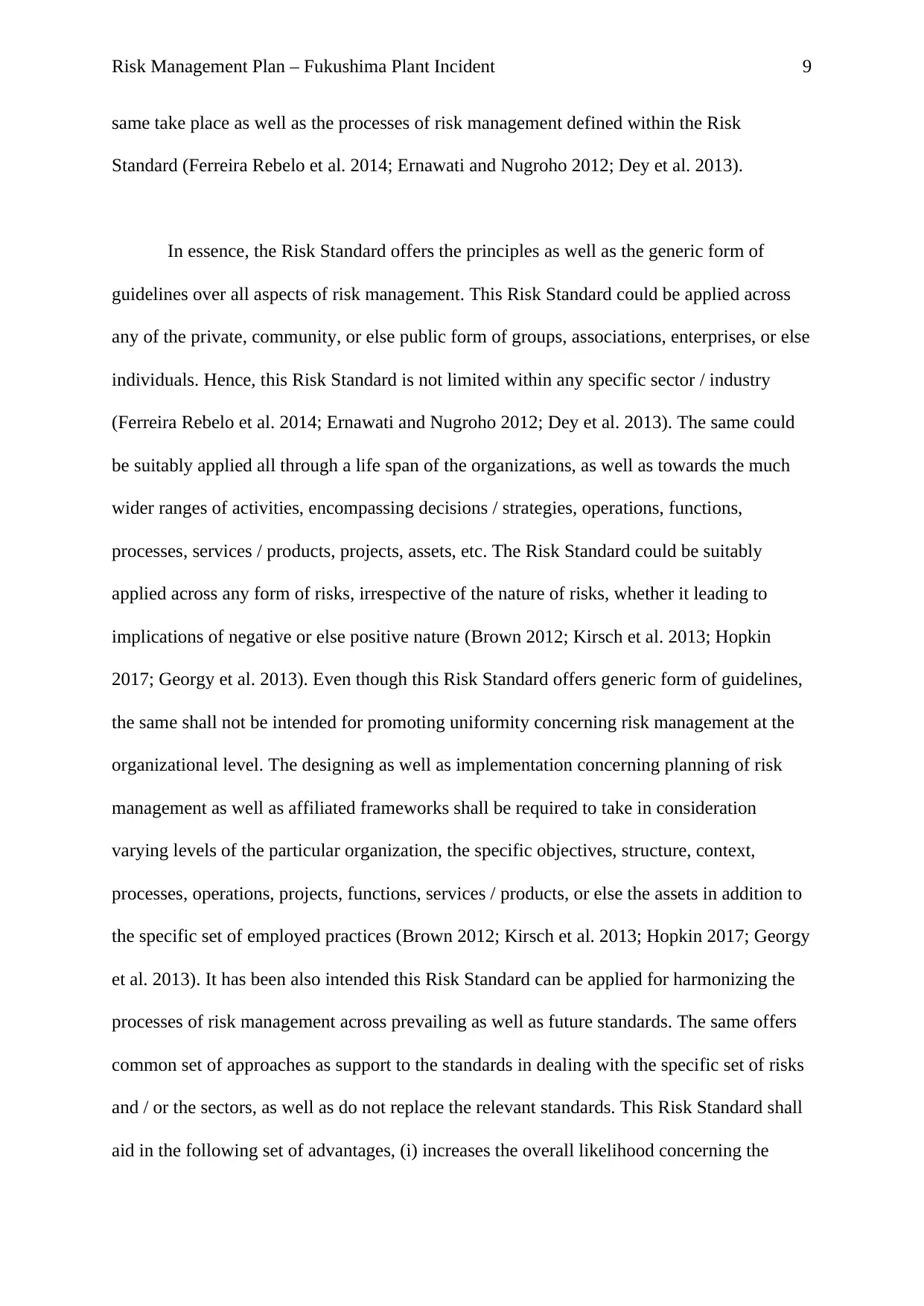
Risk Management Plan – Fukushima Plant Incident 9
same take place as well as the processes of risk management defined within the Risk
Standard (Ferreira Rebelo et al. 2014; Ernawati and Nugroho 2012; Dey et al. 2013).
In essence, the Risk Standard offers the principles as well as the generic form of
guidelines over all aspects of risk management. This Risk Standard could be applied across
any of the private, community, or else public form of groups, associations, enterprises, or else
individuals. Hence, this Risk Standard is not limited within any specific sector / industry
(Ferreira Rebelo et al. 2014; Ernawati and Nugroho 2012; Dey et al. 2013). The same could
be suitably applied all through a life span of the organizations, as well as towards the much
wider ranges of activities, encompassing decisions / strategies, operations, functions,
processes, services / products, projects, assets, etc. The Risk Standard could be suitably
applied across any form of risks, irrespective of the nature of risks, whether it leading to
implications of negative or else positive nature (Brown 2012; Kirsch et al. 2013; Hopkin
2017; Georgy et al. 2013). Even though this Risk Standard offers generic form of guidelines,
the same shall not be intended for promoting uniformity concerning risk management at the
organizational level. The designing as well as implementation concerning planning of risk
management as well as affiliated frameworks shall be required to take in consideration
varying levels of the particular organization, the specific objectives, structure, context,
processes, operations, projects, functions, services / products, or else the assets in addition to
the specific set of employed practices (Brown 2012; Kirsch et al. 2013; Hopkin 2017; Georgy
et al. 2013). It has been also intended this Risk Standard can be applied for harmonizing the
processes of risk management across prevailing as well as future standards. The same offers
common set of approaches as support to the standards in dealing with the specific set of risks
and / or the sectors, as well as do not replace the relevant standards. This Risk Standard shall
aid in the following set of advantages, (i) increases the overall likelihood concerning the
same take place as well as the processes of risk management defined within the Risk
Standard (Ferreira Rebelo et al. 2014; Ernawati and Nugroho 2012; Dey et al. 2013).
In essence, the Risk Standard offers the principles as well as the generic form of
guidelines over all aspects of risk management. This Risk Standard could be applied across
any of the private, community, or else public form of groups, associations, enterprises, or else
individuals. Hence, this Risk Standard is not limited within any specific sector / industry
(Ferreira Rebelo et al. 2014; Ernawati and Nugroho 2012; Dey et al. 2013). The same could
be suitably applied all through a life span of the organizations, as well as towards the much
wider ranges of activities, encompassing decisions / strategies, operations, functions,
processes, services / products, projects, assets, etc. The Risk Standard could be suitably
applied across any form of risks, irrespective of the nature of risks, whether it leading to
implications of negative or else positive nature (Brown 2012; Kirsch et al. 2013; Hopkin
2017; Georgy et al. 2013). Even though this Risk Standard offers generic form of guidelines,
the same shall not be intended for promoting uniformity concerning risk management at the
organizational level. The designing as well as implementation concerning planning of risk
management as well as affiliated frameworks shall be required to take in consideration
varying levels of the particular organization, the specific objectives, structure, context,
processes, operations, projects, functions, services / products, or else the assets in addition to
the specific set of employed practices (Brown 2012; Kirsch et al. 2013; Hopkin 2017; Georgy
et al. 2013). It has been also intended this Risk Standard can be applied for harmonizing the
processes of risk management across prevailing as well as future standards. The same offers
common set of approaches as support to the standards in dealing with the specific set of risks
and / or the sectors, as well as do not replace the relevant standards. This Risk Standard shall
aid in the following set of advantages, (i) increases the overall likelihood concerning the
⊘ This is a preview!⊘
Do you want full access?
Subscribe today to unlock all pages.

Trusted by 1+ million students worldwide
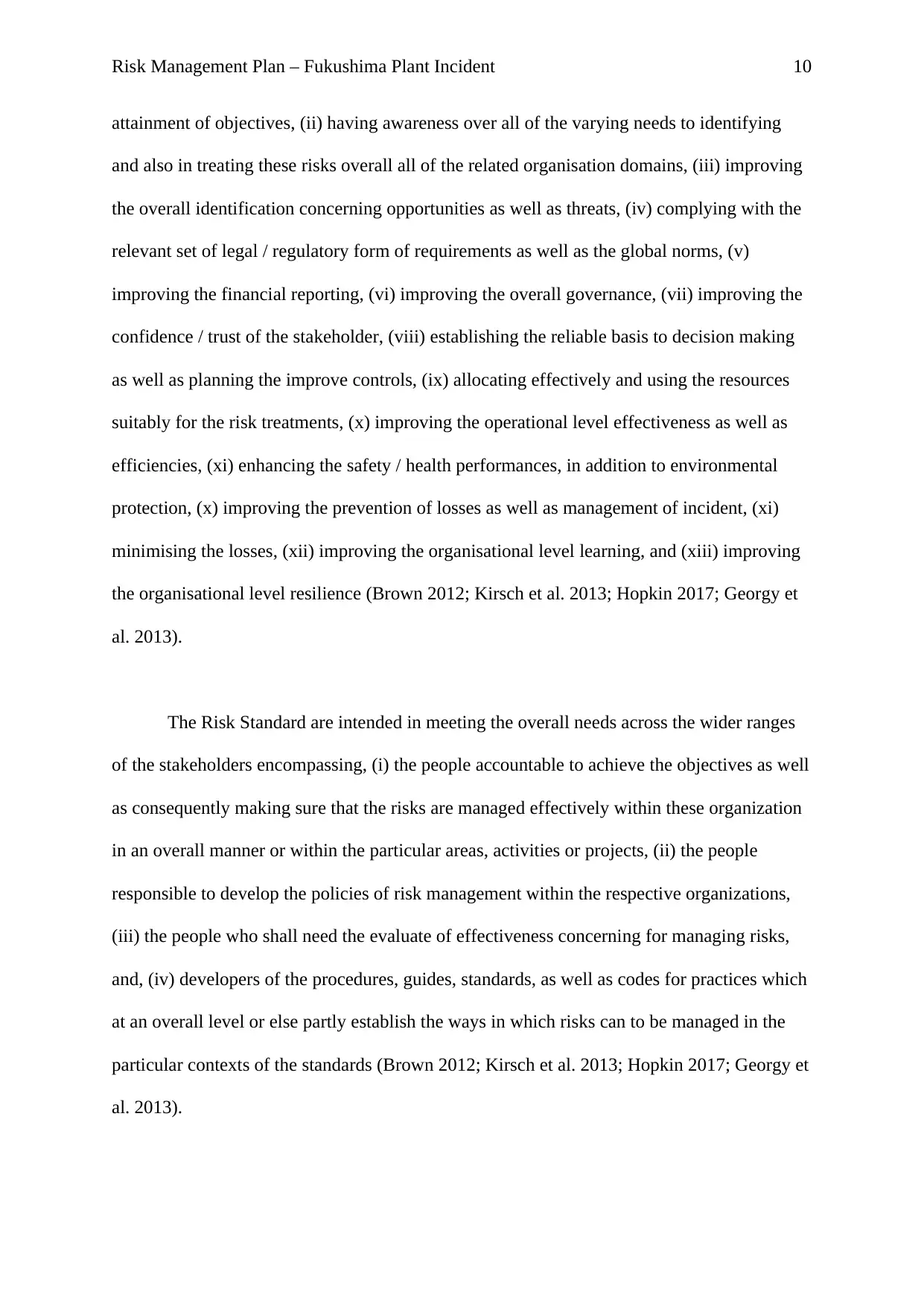
Risk Management Plan – Fukushima Plant Incident 10
attainment of objectives, (ii) having awareness over all of the varying needs to identifying
and also in treating these risks overall all of the related organisation domains, (iii) improving
the overall identification concerning opportunities as well as threats, (iv) complying with the
relevant set of legal / regulatory form of requirements as well as the global norms, (v)
improving the financial reporting, (vi) improving the overall governance, (vii) improving the
confidence / trust of the stakeholder, (viii) establishing the reliable basis to decision making
as well as planning the improve controls, (ix) allocating effectively and using the resources
suitably for the risk treatments, (x) improving the operational level effectiveness as well as
efficiencies, (xi) enhancing the safety / health performances, in addition to environmental
protection, (x) improving the prevention of losses as well as management of incident, (xi)
minimising the losses, (xii) improving the organisational level learning, and (xiii) improving
the organisational level resilience (Brown 2012; Kirsch et al. 2013; Hopkin 2017; Georgy et
al. 2013).
The Risk Standard are intended in meeting the overall needs across the wider ranges
of the stakeholders encompassing, (i) the people accountable to achieve the objectives as well
as consequently making sure that the risks are managed effectively within these organization
in an overall manner or within the particular areas, activities or projects, (ii) the people
responsible to develop the policies of risk management within the respective organizations,
(iii) the people who shall need the evaluate of effectiveness concerning for managing risks,
and, (iv) developers of the procedures, guides, standards, as well as codes for practices which
at an overall level or else partly establish the ways in which risks can to be managed in the
particular contexts of the standards (Brown 2012; Kirsch et al. 2013; Hopkin 2017; Georgy et
al. 2013).
attainment of objectives, (ii) having awareness over all of the varying needs to identifying
and also in treating these risks overall all of the related organisation domains, (iii) improving
the overall identification concerning opportunities as well as threats, (iv) complying with the
relevant set of legal / regulatory form of requirements as well as the global norms, (v)
improving the financial reporting, (vi) improving the overall governance, (vii) improving the
confidence / trust of the stakeholder, (viii) establishing the reliable basis to decision making
as well as planning the improve controls, (ix) allocating effectively and using the resources
suitably for the risk treatments, (x) improving the operational level effectiveness as well as
efficiencies, (xi) enhancing the safety / health performances, in addition to environmental
protection, (x) improving the prevention of losses as well as management of incident, (xi)
minimising the losses, (xii) improving the organisational level learning, and (xiii) improving
the organisational level resilience (Brown 2012; Kirsch et al. 2013; Hopkin 2017; Georgy et
al. 2013).
The Risk Standard are intended in meeting the overall needs across the wider ranges
of the stakeholders encompassing, (i) the people accountable to achieve the objectives as well
as consequently making sure that the risks are managed effectively within these organization
in an overall manner or within the particular areas, activities or projects, (ii) the people
responsible to develop the policies of risk management within the respective organizations,
(iii) the people who shall need the evaluate of effectiveness concerning for managing risks,
and, (iv) developers of the procedures, guides, standards, as well as codes for practices which
at an overall level or else partly establish the ways in which risks can to be managed in the
particular contexts of the standards (Brown 2012; Kirsch et al. 2013; Hopkin 2017; Georgy et
al. 2013).
Paraphrase This Document
Need a fresh take? Get an instant paraphrase of this document with our AI Paraphraser
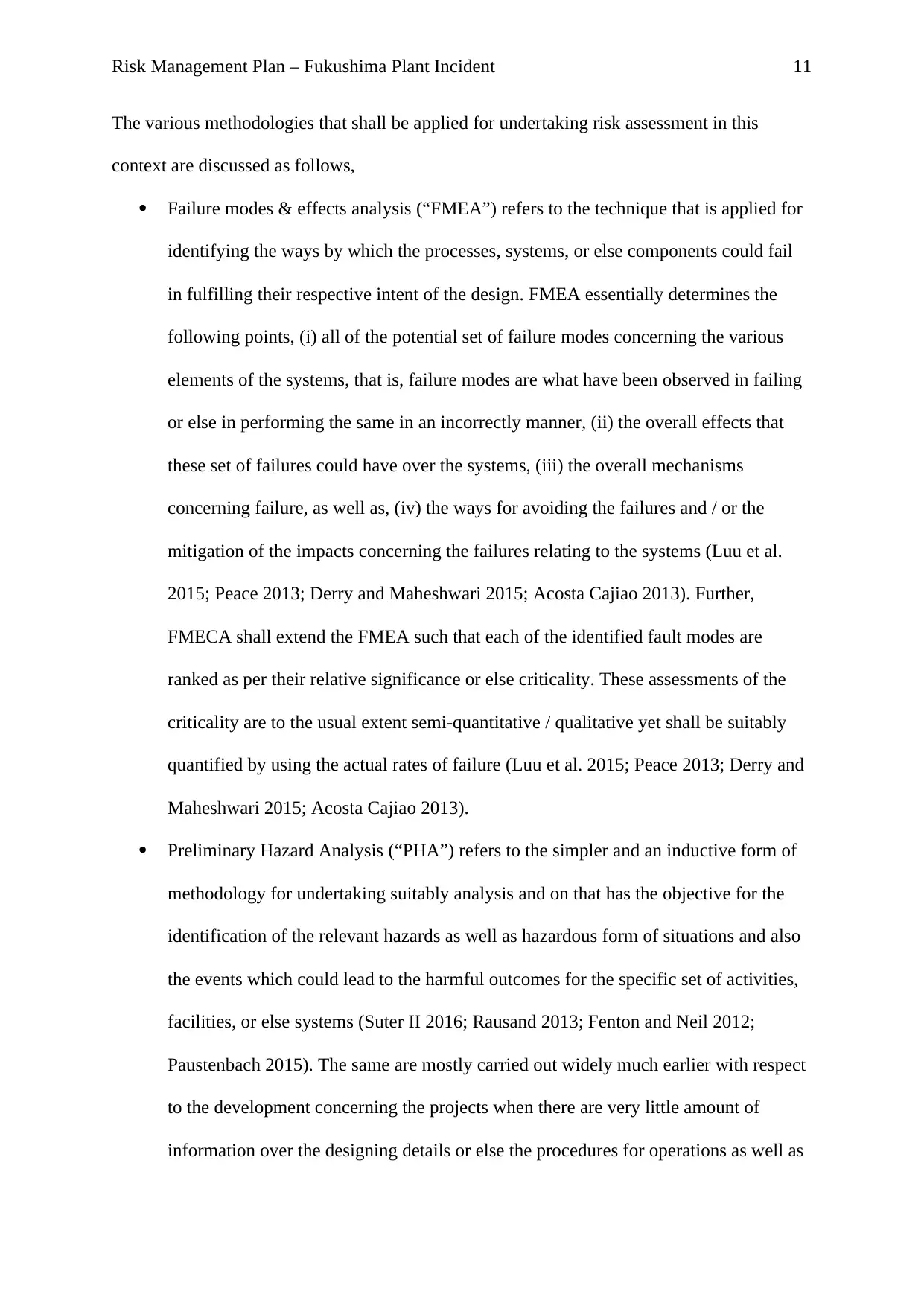
Risk Management Plan – Fukushima Plant Incident 11
The various methodologies that shall be applied for undertaking risk assessment in this
context are discussed as follows,
Failure modes & effects analysis (“FMEA”) refers to the technique that is applied for
identifying the ways by which the processes, systems, or else components could fail
in fulfilling their respective intent of the design. FMEA essentially determines the
following points, (i) all of the potential set of failure modes concerning the various
elements of the systems, that is, failure modes are what have been observed in failing
or else in performing the same in an incorrectly manner, (ii) the overall effects that
these set of failures could have over the systems, (iii) the overall mechanisms
concerning failure, as well as, (iv) the ways for avoiding the failures and / or the
mitigation of the impacts concerning the failures relating to the systems (Luu et al.
2015; Peace 2013; Derry and Maheshwari 2015; Acosta Cajiao 2013). Further,
FMECA shall extend the FMEA such that each of the identified fault modes are
ranked as per their relative significance or else criticality. These assessments of the
criticality are to the usual extent semi-quantitative / qualitative yet shall be suitably
quantified by using the actual rates of failure (Luu et al. 2015; Peace 2013; Derry and
Maheshwari 2015; Acosta Cajiao 2013).
Preliminary Hazard Analysis (“PHA”) refers to the simpler and an inductive form of
methodology for undertaking suitably analysis and on that has the objective for the
identification of the relevant hazards as well as hazardous form of situations and also
the events which could lead to the harmful outcomes for the specific set of activities,
facilities, or else systems (Suter II 2016; Rausand 2013; Fenton and Neil 2012;
Paustenbach 2015). The same are mostly carried out widely much earlier with respect
to the development concerning the projects when there are very little amount of
information over the designing details or else the procedures for operations as well as
The various methodologies that shall be applied for undertaking risk assessment in this
context are discussed as follows,
Failure modes & effects analysis (“FMEA”) refers to the technique that is applied for
identifying the ways by which the processes, systems, or else components could fail
in fulfilling their respective intent of the design. FMEA essentially determines the
following points, (i) all of the potential set of failure modes concerning the various
elements of the systems, that is, failure modes are what have been observed in failing
or else in performing the same in an incorrectly manner, (ii) the overall effects that
these set of failures could have over the systems, (iii) the overall mechanisms
concerning failure, as well as, (iv) the ways for avoiding the failures and / or the
mitigation of the impacts concerning the failures relating to the systems (Luu et al.
2015; Peace 2013; Derry and Maheshwari 2015; Acosta Cajiao 2013). Further,
FMECA shall extend the FMEA such that each of the identified fault modes are
ranked as per their relative significance or else criticality. These assessments of the
criticality are to the usual extent semi-quantitative / qualitative yet shall be suitably
quantified by using the actual rates of failure (Luu et al. 2015; Peace 2013; Derry and
Maheshwari 2015; Acosta Cajiao 2013).
Preliminary Hazard Analysis (“PHA”) refers to the simpler and an inductive form of
methodology for undertaking suitably analysis and on that has the objective for the
identification of the relevant hazards as well as hazardous form of situations and also
the events which could lead to the harmful outcomes for the specific set of activities,
facilities, or else systems (Suter II 2016; Rausand 2013; Fenton and Neil 2012;
Paustenbach 2015). The same are mostly carried out widely much earlier with respect
to the development concerning the projects when there are very little amount of
information over the designing details or else the procedures for operations as well as
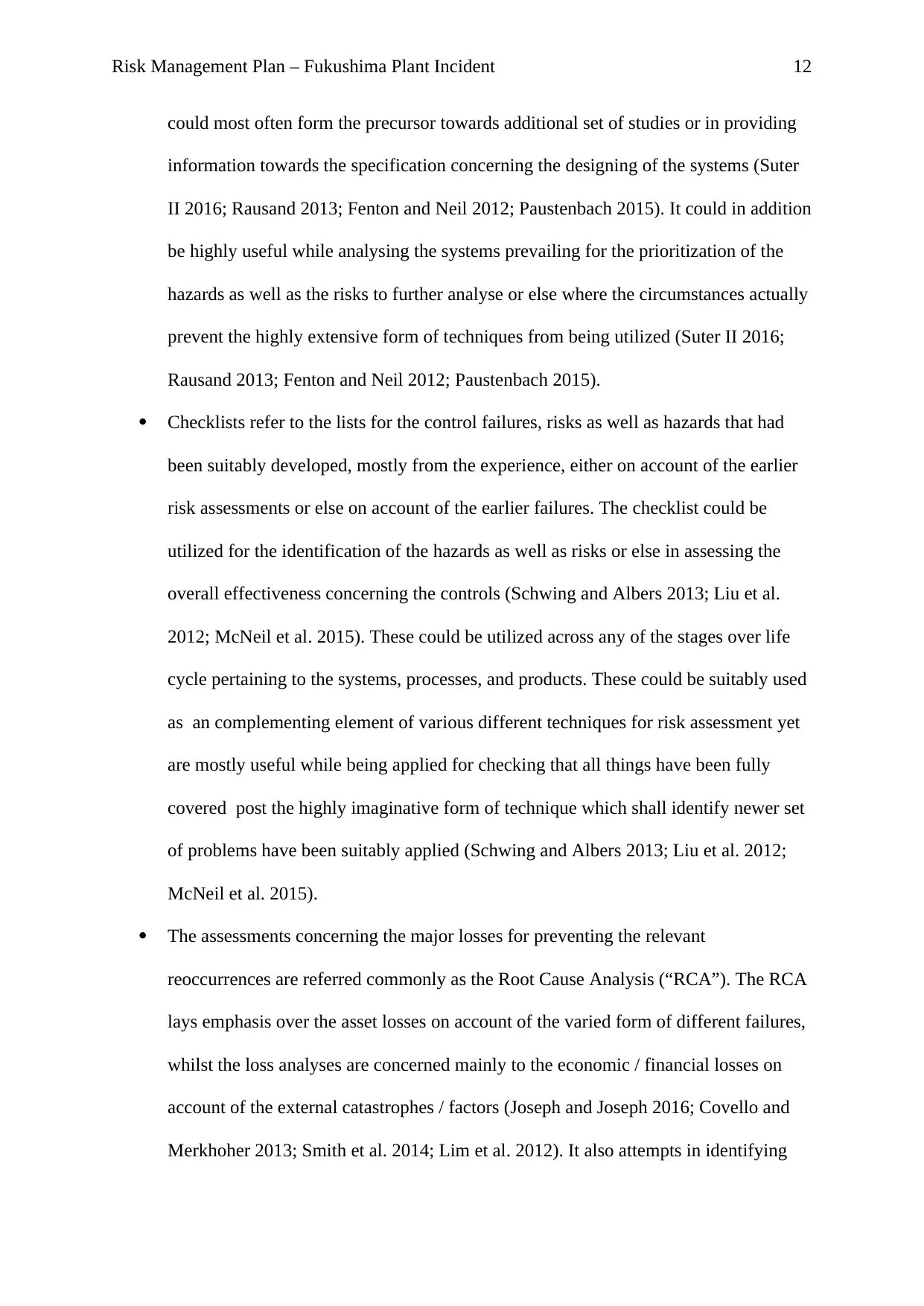
Risk Management Plan – Fukushima Plant Incident 12
could most often form the precursor towards additional set of studies or in providing
information towards the specification concerning the designing of the systems (Suter
II 2016; Rausand 2013; Fenton and Neil 2012; Paustenbach 2015). It could in addition
be highly useful while analysing the systems prevailing for the prioritization of the
hazards as well as the risks to further analyse or else where the circumstances actually
prevent the highly extensive form of techniques from being utilized (Suter II 2016;
Rausand 2013; Fenton and Neil 2012; Paustenbach 2015).
Checklists refer to the lists for the control failures, risks as well as hazards that had
been suitably developed, mostly from the experience, either on account of the earlier
risk assessments or else on account of the earlier failures. The checklist could be
utilized for the identification of the hazards as well as risks or else in assessing the
overall effectiveness concerning the controls (Schwing and Albers 2013; Liu et al.
2012; McNeil et al. 2015). These could be utilized across any of the stages over life
cycle pertaining to the systems, processes, and products. These could be suitably used
as an complementing element of various different techniques for risk assessment yet
are mostly useful while being applied for checking that all things have been fully
covered post the highly imaginative form of technique which shall identify newer set
of problems have been suitably applied (Schwing and Albers 2013; Liu et al. 2012;
McNeil et al. 2015).
The assessments concerning the major losses for preventing the relevant
reoccurrences are referred commonly as the Root Cause Analysis (“RCA”). The RCA
lays emphasis over the asset losses on account of the varied form of different failures,
whilst the loss analyses are concerned mainly to the economic / financial losses on
account of the external catastrophes / factors (Joseph and Joseph 2016; Covello and
Merkhoher 2013; Smith et al. 2014; Lim et al. 2012). It also attempts in identifying
could most often form the precursor towards additional set of studies or in providing
information towards the specification concerning the designing of the systems (Suter
II 2016; Rausand 2013; Fenton and Neil 2012; Paustenbach 2015). It could in addition
be highly useful while analysing the systems prevailing for the prioritization of the
hazards as well as the risks to further analyse or else where the circumstances actually
prevent the highly extensive form of techniques from being utilized (Suter II 2016;
Rausand 2013; Fenton and Neil 2012; Paustenbach 2015).
Checklists refer to the lists for the control failures, risks as well as hazards that had
been suitably developed, mostly from the experience, either on account of the earlier
risk assessments or else on account of the earlier failures. The checklist could be
utilized for the identification of the hazards as well as risks or else in assessing the
overall effectiveness concerning the controls (Schwing and Albers 2013; Liu et al.
2012; McNeil et al. 2015). These could be utilized across any of the stages over life
cycle pertaining to the systems, processes, and products. These could be suitably used
as an complementing element of various different techniques for risk assessment yet
are mostly useful while being applied for checking that all things have been fully
covered post the highly imaginative form of technique which shall identify newer set
of problems have been suitably applied (Schwing and Albers 2013; Liu et al. 2012;
McNeil et al. 2015).
The assessments concerning the major losses for preventing the relevant
reoccurrences are referred commonly as the Root Cause Analysis (“RCA”). The RCA
lays emphasis over the asset losses on account of the varied form of different failures,
whilst the loss analyses are concerned mainly to the economic / financial losses on
account of the external catastrophes / factors (Joseph and Joseph 2016; Covello and
Merkhoher 2013; Smith et al. 2014; Lim et al. 2012). It also attempts in identifying
⊘ This is a preview!⊘
Do you want full access?
Subscribe today to unlock all pages.

Trusted by 1+ million students worldwide
1 out of 23
Your All-in-One AI-Powered Toolkit for Academic Success.
+13062052269
info@desklib.com
Available 24*7 on WhatsApp / Email
![[object Object]](/_next/static/media/star-bottom.7253800d.svg)
Unlock your academic potential
Copyright © 2020–2025 A2Z Services. All Rights Reserved. Developed and managed by ZUCOL.

